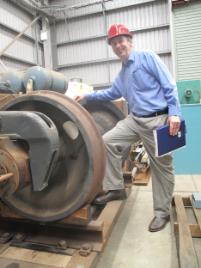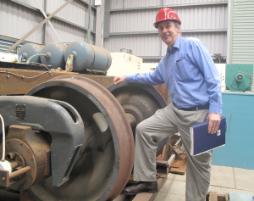Millimetres can save millions when rail research on track
Published on 31 January, 2011
Incremental changes can save millions of dollars for railway systems, thanks to researchers squeezing out every possible performance enhancement. Sometimes tiny adjustments are enough when translated to hundreds of trains and thousands of kilometres of rail lines.
That's according to Professor Colin Cole, Director of CQUniversity's Centre for Railway Engineering (CRE), which partners* with with railway owners and peak bodies across Australia.

Professor Colin Cole in the CRE laboratory
The team that has been helping locomotive drivers see the condition of their trains 50 seconds into the future is also forging ahead with a myriad of other projects to keep the rail industry on track.
CRE researchers may be keeping an eye on their Intelligent Train Monitor prototype testing but their innovative vision is also extending in many other directions.
"Recently we've have had further projects approved in the human factors area including work on platform gaps, work on monitoring the safety of railway level crossings using video and work on what we call high-risk level crossing users. These projects are in their seed grant stage and could proceed into much larger projects this year," Professor Cole said.
"Also on safety we are completing simulation studies of trains in crash scenarios for a revision of the Australian rollingstock crash worthiness standards.
"For 2011 we also have new projects approved in technologies for track worker protection, new work on locomotive adhesion and the problems associated with rail damage and also a large project on the lifecycle management and maintenance of rail bridges."
CRE specialists are taking on the challenge to develop new low-cost level crossing technologies that offer equivalent or improved safety. The latest rail crossing project includes academics and students and both the engineering and human factors disciplines, since reduction of human error is a prime goal. A second stage to this project is expected to be approved in February.
The ‘curve lubrication' partners have been eyeing big benefits from reduction in wheel wear, noise and energy usage, if the best combination of lubricants and applicators can be found to literally grease the wheels of commerce.
The heat is also on the track stability management team to help operators use weather prediction data to avert problems caused by thermal expansion and contraction. Weather forecasts coupled with likely incident predictions should help rail owners manage train operations in advance. The project will also investigate a practical combination of methods to manage track buckling risks and speed restriction settings. Ideas are being explored to extend this approach to other extreme weather, high winds and floods.
What of the future? Well, CQUniversity researchers are now becoming futurists, looking at entirely new engine systems, possibly even hybrids, to drive the rail industry further into our ‘carbon-concious' century. Existing and future technologies are being evaluated in current projects.
CRE researchers are already helping drivers see 50 seconds around the next bend. Perhaps they can also help the entire rail industry see into the next 50 years.
Much of the technology jumping off drawing boards could under-perform if a crucial component is overlooked - the operators.
With this in mind, CQUniversity is involving specialists in human interaction with equipment. Often, potentially beneficial and expensive technologies are rejected by the users or unexpectedly make things worse.
An example is the need for new locomotive cabin and control panel layouts to ‘make sense' when drivers need to use them.
And CQUniversity researchers believe the drivers will want to use the new technologies, since at least one of them can help see into the future, albeit just a little bit into the future.
The Intelligent Train Monitor is able to predict train speeds and wagon coupling forces by comparing the coming track geometry with a mathematical model of likely performance.
Forewarned, drivers can modify their control settings to anticipate and improve compliance with speed limits, providing reductions in energy use, component fatigue and brake pad wear.
Using a database, GPS and transducers on the locomotive, there may be no need for monitors on the wagons under this system. Such technology is expected to be in increased demand as train sizes in Australia grow to 50,000 tonnes and over 3km long.
Meanwhile, another research project aims to develop a Train Health Advisory System to monitor and detect things like flat wheels, strange wagon behaviours, derailments and track irregularities.
The multi-partner project will involve proof-of-concept testing of cost-effective wagon monitoring systems that have the potential to revolutionise the way rolling stock is managed and maintained.
Finally, there's even a project proving that researchers are not too smitten by the future to recall the past. The CRE aims to check whether disused flat bottom railway wagons are structurally strong enough to be used to build the decks for road bridges. Laboratory testing has been completed and now work is progressing on a field trial of a proof-of-concept bridge.
In another big laboratory-based project, full-scale destructive testing of rail joints will be completed this year.
Professor Cole and his fellow CRE researchers Dr Yan Sun and Mitchell McClanachan have found their study of wheel impact has made a real impact on a global level.
Their article on the calculation of wheel impact force due to the interaction between vehicle and a turnout (track change) was the 'top downloaded article' among all those published last year in the London-based Journal of Rail and Rapid Transit.
Published by SAGE Publications Ltd, this journal is part of the Proceedings of the Institution of Mechanical Engineers.
Professor Cole said the JRRT is an A-ranked journal recognised as one of the best railway specific journals in the world.
"It also shows that ‘industry-selected research' drives research that is of great interest," he said.
"This work was derived from the CRC for Rail Innovation Project on Short Pitch Irregularities chaired by Malcolm Kerr from RailCorp."
Professor Cole said that operation of trains through turnouts, that is, when it is necessary for trains to change tracks, always leads to some impacts as wheels switch from one rail to another.
"The impacts, in turn, lead to track degradation requiring maintenance. It is important to understand how to prioritise maintenance to ensure train safety and apply maintenance to the most damaging faults first to reduce costs," he said.
* CRE partners (either direct or via the CRC for Rail Innovation) include: QR National, Queensland Rail, Pacific National, the Australian Rail Track Corporation, Rail Innovation Australia, Rio Tinto, RailCorp, Department of Transport (Vic); the Public Transport Authority of Western Australia, MetroTrains, Fortescue Metals Group, and the Australian Rail Association.


